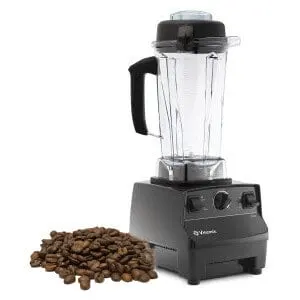 This is a pretty common conundrum many people face. Can blenders do dry grinding? Everybody wants to know the answer to this question, and it is actually a little more complicated than it may seem. Almost every blender on earth advertises the ability to grind dry ingredients, but can it actually be done?
This is a pretty common conundrum many people face. Can blenders do dry grinding? Everybody wants to know the answer to this question, and it is actually a little more complicated than it may seem. Almost every blender on earth advertises the ability to grind dry ingredients, but can it actually be done?
The truth is that blenders are not designed for dry grinding. It can be done, but they are not meant for it. Even though many blenders come included with a dry container for such an eventuality, it takes a pretty powerful machine to do dry grinding.
And that’s kind of what it comes down to at the end of the day. How powerful is your blender? Do you have a small, 250-watt personal blender or a $1000-dollar professional blender? This actually makes a huge difference. With enough speed and power, you can definitely grind grains, crack open nuts, and make your own powders. But a wimpier blender may not cut it.
Read More: Grinding Spices in a Vitamix Blender – 5 Simple Steps
Downsides to Dry Grinding with a Blender
There are definitely a few setbacks you can expect when blending dry ingredients with your blender. This is especially true if you have a poorer quality blender, an old blender that is already worn, or a personal blender with not a lot of power.
Anything can be ground when put into a blender. Even a rock will eventually be chipped away until it turns to dust. That said, even water dripping on a rock for long enough will break it apart. What I’m trying to say is that you can grind any kind of dry ingredient with your blender, but it might not be pretty.
One of the biggest issues is how blending dry ingredients hurt your blades. If you are constantly grinding beans, hard nuts, and all kinds of dry grains, the blades are going to take an absolute beating. If they are not special grinding blades, which you can and find on some brands of blenders, they are going to be beaten up. It’s like running your lawnmower over rocks repeatedly.
Another downside to grinding dry ingredients is that it could have a pretty nasty effect on your blender motor. Because of your blender needing to work so hard, it will put stress on your motor, which can lead to overheating and functionality issues.
Because of how tall most blender containers are, another ugly side effect of grinding something hard into a fine powder, like spice for example, is that it can lead to dust particles flying up into the air when you take the lid off. There’s nothing like a cloud of black pepper to make you cough for the next hour. This is why it is always recommended that you use a dry grain container when grinding with your blender.
Read More: Can a Vitamix Chop Nuts – 4 Reasons and Amazing Benefits
Best Ways to Dry Grind with a Blender
The best way to blend and grind dry ingredients is with a special spice grinder, a mortar and pestle, or with an actual grinding blender. These machines are specially designed for grinding dry ingredients. You can of course use a normal smoothie blender, but using an actual dry blender is recommended.
With that obvious warning out of the way, I will tell you the best ways to grind dry ingredients using your normal blender. The first thing you need is a powerful blender. I always recommend using a Vitamix for grinding dry ingredients. This is because the Vitamix is powerful, it is proven to work, and you can purchase the Vitamix with a dry grains container.
The dry grains container on the Vitamix is designed to better grind your dry ingredients. Whether you are making a dry cereal, turning some nuts into powder, or even just grinding coffee beans, it is always recommended that you use a dry grains container.
If you absolutely must use your blender for grinding, I will explain in the next section the very best method for doing so.
Related Articles:
How to Grind with Your Blender
Before you throw a handful or a bucketful of dry ingredients into your blender, you can prepare them for easier grinding. Your blender might have a hard time with full coffee beans, but if you do some smart prepping, you will save your blender a bit of trouble, and you will get a better end result.
The first step is to get a zip lock bag and fill it with your dry ingredients. Everything you want to put in the blender for grinding, first put it all in a plastic bag, preferably a zip lock. Then you want to flatten your bag on a cutting board and get yourself a hammer.
No, not a claw hammer for construction. You want a small kitchen hammer with spikes on it. You are going to use this hammer to bash apart the dry ingredients to turn them into smaller pieces inside the bag. This will give you a very coarse powder. But it will be much better for your blender.
The next step is to empty the contents of the plastic bag into your blender and turn it on to the highest setting. Blend until you have a fine powder. This applies to any kind of dry ingredient.
Read More: Can A Vitamix Grind Bones: A Comprehensive Guide
Can Blenders do Dry Grinding: Notes
Most quality blenders will come with a grinder setting. Many also come with special grinding blades. You can trade the grinding blades for the blending blades and then use the grinder setting for your dry ingredients. If you have a blender with these two features, you probably don’t need to do any extra steps. Simply pour in your hard ingredients and then grind.
However, do keep in mind that all this grinding is going to cause a lot of heat. You’ll end up with a pocket of incredible heat inside your blender, and this could cook the natural oils found inside of beans and nuts. In the case of grinding coffee beans, this could leave you with a horrible tasting coffee grind.
Whenever you finish grinding with your blender, always give it a wash or you may find it stained with an unpleasant aroma.
Read More: Turmeric Vs Cumin: What Is The Difference?
